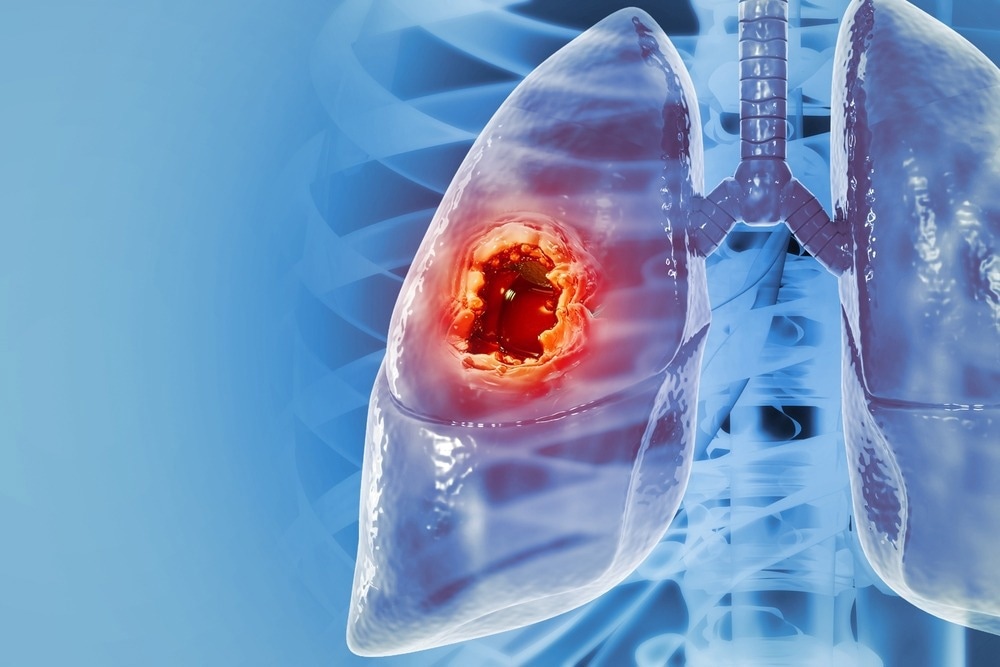Researchers use spatial transcriptomics to uncover tumor microenvironment patterns linked to treatment response in non-small-cell lung cancer

In a recent study published in Nature Genetics, researchers characterized the spatial cellular compositions and tumor cell states of the tumor microenvironment (TME) in non-small cell lung cancer (NSCLC).
Background
Immune checkpoint blockade (ICB) treatment has revolutionized NSCLC care, even curing advanced-stage disease. Although neoadjuvant immunochemotherapy is more effective than ICB alone, many NSCLC patients develop resistance to neoadjuvant immunochemotherapy, and the underlying resistance mechanisms are unclear.
The TME encompasses diverse stromal and immune cells that contribute to immune escape and tumor growth. Single-cell RNA sequencing (scRNA-seq) has been extensively used to explore resistance-linked features. These studies indicated that while neoadjuvant ICB therapy can partially reprogram the TME and elevate T cell infiltration, the environment remains suppressive, limiting efficacy.
The study and findings
In the present study, researchers profiled the spatial organization and cellular composition of tumor cells and the TME before and after neoadjuvant ICB-chemotherapy in non-responders and responders. First, they profiled tumor samples from 19 NSCLC patients before and after neoadjuvant anti-PD-1 therapy and chemotherapy using scRNA-seq. Besides, spatial transcriptomic analyses were performed on treatment-naïve and post-treatment samples.
Six patients were responders, while 13 were non-responders. Following quality control, transcriptomes of more than 232,000 individual cells were derived. Unsupervised clustering was performed to explore cellular compositions. This yielded nearly 65,000 epithelial cells, which formed two major clusters (presumably malignant and normal cells). Further unsupervised analyses revealed 21 epithelial subclusters (13 malignant and eight normal).
Malignant cells were eliminated in the epithelial cell compartment in responders after ICB-chemotherapy. There were changes in stromal and immune compartments. Cancer cell states were examined using scRNA-seq data. These cells were stratified into 14 subsets and annotated via gene set enrichment analysis. Cell states clustered into two groups. One group comprised cell cycle-related, squamous, and nuclear factor erythroid 2-related factor 2 (NRF2) target cell states.
The other group comprised alveolar, estrogen, interferon (IFN), coagulation and extracellular matrix cell states. Notably, cancer cell states were highly anticorrelated in these groups. Some states (IFN, estrogen, and alveolar) were linked to prolonged survival, while others (squamous, cell cycle, and NRF2 target) were related to poor survival across patients in a different cohort.
Next, the team compared cell proportions between non-responders and responders at the tumor boundary pre- and post-therapy. Non-responders had a higher proportion of collagen type XI alpha 1 chain-positive (COL11A1+) cancer-associated fibroblasts (CAFs) and a lower proportion of cluster of differentiation 8 (CD8) T cells than responders. In non-responders, COL11A1+ CAFs aggregated at isolated tumor boundaries but decreased in stromal regions away from malignant cells.
By contrast, alcohol dehydrogenase 1B-positive (ADH1B+) CAFs were enriched in tumor stromal areas. Next, the researchers examined associations between T cells and COL11A1+ CAFs. The abundance of COL11A1+ CAFs around malignant cells correlated negatively with T-cell abundance in all samples containing malignant cells. Further, the team assessed whether the abundance of COL11A1+ CAFs could be a prognostic marker for NSCLC.
Hazard ratios for cohorts on ICB therapy were higher than those of chemotherapy and treatment-naïve cohorts. Next, they focused on the relationship between COL11A1+ CAFs and macrophages in NSCLC, as prior studies have suggested that macrophage-CAF interactions promote tumor growth in liver and colon cancers. scRNA-seq data showed a positive association between secreted phosphoprotein 1-positive (SPP1+) macrophages and COL11A1+ CAFs.
Like COL11A1+ CAFs, SPP1+ macrophages were higher in non-responders before and after treatment, accumulated at tumor boundaries, and had lower abundance in stromal regions away from the tumor. Multiplex immunohistochemistry staining revealed that SPP1+ macrophages localized with COL11A1+ CAFs at the tumor boundary, while T cells were blocked by the combination of these cells. Tertiary lymphoid structures (TLSs) were prevalent in the TME following ICB-chemotherapy.
Further, the team characterized the maturation process of TLSs. The maturation stages of TLSs, as indicated by k-means clustering, were early lymphoid aggregates, activated TLSs, declining TLSs, and late TLSs. TLS maturation states were remarkably diverse among patients with different responses. Activated TLSs were associated with improved prognosis. Additional analyses indicated that hypoxic TME may suppress TLS development.
Conclusions
Together, the study presented a high-resolution spatial cellular and molecular atlas of the NSCLC TME before and after neoadjuvant ICB-chemotherapy. The team revealed 14 distinct states of cancer cells in NSCLC specimens. Cancer cell states associated with IFN-γ and NRF2 targets were linked to favorable and poor responses to ICB-chemotherapy, respectively.
Non-responders showed significantly more abundant COL11A1+ CAFs than responders. COL11A1+ CAFs were mainly localized at tumor boundaries after treatment and could block contact between immune cells and tumor cells. Overall, the results underscore the potential of therapies targeting multiple TME components, opening avenues to develop combinatorial therapies.
Journal reference:
-
Yan Y, Sun D, Hu J, et al. Multi-omic profiling highlights factors associated with resistance to immuno-chemotherapy in non-small-cell lung cancer. Nature Genetics, 2024. doi: 10.1038/s41588-024-01998-y https://www.nature.com/articles/s41588-024-01998-y




